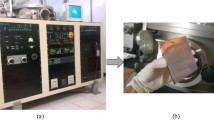Abstract
A-SiGe n-i-p solar cells with i-layer deposited via plasma enhanced chemical vapor deposition (PECVD) with a germane to disilane ratio of 0.72 and hydrogen dilution R=(H2 flow)/(GeH4+Si2H6 flow) values of 1.7, 10, 30, 50, 120, 180 and 240 were deposited on stainless steel substrates. This germane to disilane ratio is what we typically use for the i-layer in the bottom cell of our standard triple-junction solar cells. Solar cell current-voltage curves (J-V) and quantum efficiency (QE) were measured for these devices. Light soaking tests were performed for these devices under 1 sun light intensity at 50° C. While device with R=30 showed the highest initial efficiency, the device with R=120 exhibit higher stabilized efficiency after 1000 hours of light soaking.
Single-layer a-SiGe films (∼500 nm thick) were deposited under the same conditions as the i-layer of these devices on a variety of substrates including 7059 glass, crystalline silicon, and stainless steel for visible-IR transmission spectroscopy, FTIR, and hydrogen effusion studies. It is interesting to note 1) the H content in the film decreased with increasing R based on both the IR and H effusion measurements, and 2) while the H content changes significantly with different R, the change in Eg is relatively small. This is most likely due to a change in Ge content in the film for different R.
Similar content being viewed by others
References
L. Yang, L. Chen, and A. Catalano, MRS Proc. 219, 259 (1991).
J. Yang, X. Xu and, MRS Proc. 336, 687 (1994).
M. Shima, M. Isomura, E. Maruyama, S. Okamoto, H. Haku, K. Wakisaka, S. Kiyama, and S. Tsuda, MRS Proc. 507, 145 (1998).
S. Guha, K.L. Narasimhan, and S.M. Pietruszko, J. Appl. Phys. 52, 859 (1981).
K. Tanaka and A. Matsuda, MRS Proc. 70, 245 (1986).
J. Yang and, MRS Proc. 557, 239 (1999).
R. Swanepoel, J. Phys. E: Sci. Instrum. 16, pp. 1214–1222 (1983).
A. D. Compaan and X. Deng, University of Toledo 1999 2nd Quarterly Report submitted to NREL under the Thin Film Partnership Program (1999).
J. Yang, R. Ross, T. Glatfelter, R. Mohr, and S. Guha, MRS Proc. 149, 435 (1989).
X. Deng, X. B. Liao, S. Han, H. Povolny, P. Agarwal, Solar Energy Mat. & Solar Cells, 2000.
Author information
Authors and Affiliations
Rights and permissions
About this article
Cite this article
Povolny, H., Agarwal, P., Han, S. et al. Comparison Study of a-SiGe Solar Cells and Materials Deposited Using Different Hydrogen Dilution. MRS Online Proceedings Library 609, 303 (1999). https://doi.org/10.1557/PROC-609-A30.3
Published:
DOI: https://doi.org/10.1557/PROC-609-A30.3




